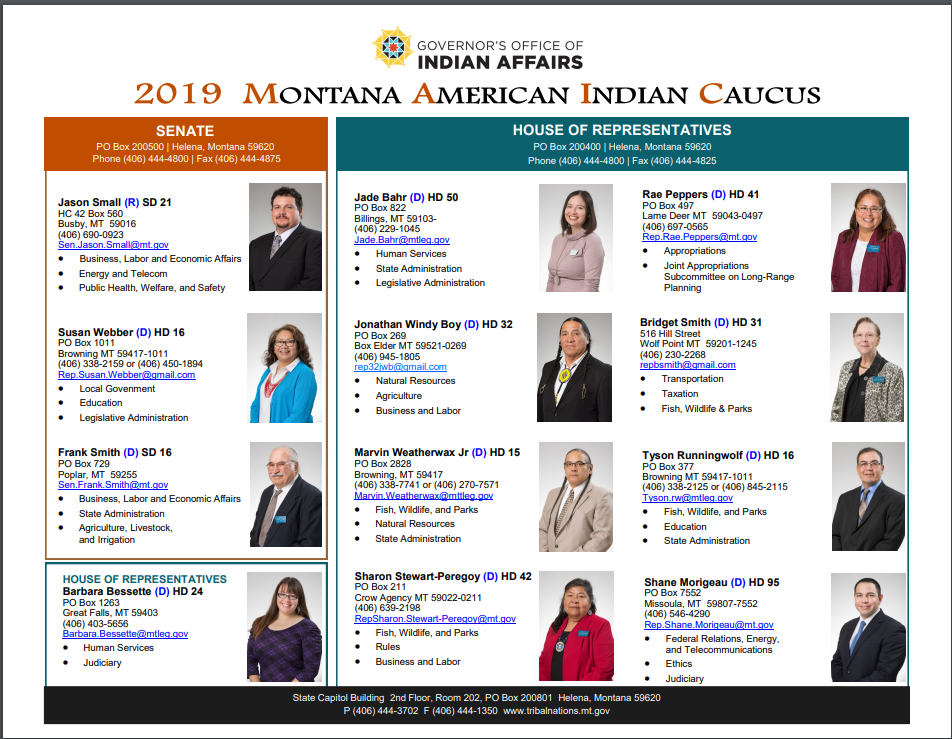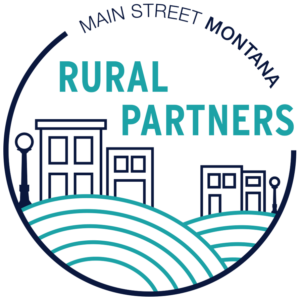Population Cooperation
Montana
Savannah & Liz

The Importance of Representation
It is undeniable that Indigenous individuals and communities are often placed at a major disadvantage when it comes to receiving sufficient political representation, funding, economic opportunity, and other essential resources from the federal government. More than 500 Native Nations in the United States continue to fight for a platform in our political and economic systems in order to address the problems that are unique to Indian Country. Rather than focusing on the shortcomings and injustices that are occuring in and around these Indigenous communities, we would like to highlight an example of how prioritizing Indigenous advocacy and political representation at the State level can create the space that is needed for Native and non-Native communities to work together in harmony. We will be specifically looking at the state of Montana due to the number of Indigenous men and women within their State Legislature.
Voting Rights

The relationship between the United States and those of Native Americans has been, with historical justification, underlined by mistrust. Engaging in the United States electoral process has been discouraged by, not only United States legislation, but also by Native American actors, who are wary of the threat to their sovereignty. In 1994, Chief Irving Powless Jr spoke to the U.S. government, "You passed a law that says we are U.S. citizens... We did not agree to be U.S citizens and we did not agree that your governments could have jurisdiction over us. We do not accept these laws. We are not citizens of the U.S." (Wilkins & Stark, 2017, p 198). There is an "ongoing constitutional tension" between Tribal governments and the United States based on the U.S.'s past assimilation agenda, which continues to threaten Native American culture (Wilkins & Stark, 2017, p 210).
These attitudes are, for the most part, changing. They have entered the United States political process, not as a way of surrender, but as a way to protect their sovereignty (Wilkins & Stark, 2017).
Montana enjoys a proportional amount of Native American representation partly because of their commitment to enforcing voting rights. The Indian Citizenship Act of 1924 declared that Native Americans were U.S. citizens, and deserved to enjoy the same rights. The Voting Rights Act of 1965’s purpose was to end discriminatory voting eligibility practices, especially towards non-white citizens (Wilkins & Stark, 2017). However, states found other ways to discourage Native American voters. Montana is no exception.
For example, in 1937, Montana state law was that only federal taxpayers could vote. Since Native Americans are exempt from federal taxes, this barred them from the polls. These laws perpetuate a narrative between the states and Native governments of distrust. These laws were in effect until 1975 (Thomas-Lundborg & Alvernaz, 2020).
Besides legislation, there are many other obstacles to the Native American vote in Montana. Many Native Americans residing on reservations live on or below the poverty level, lacking access to car insurance or fuel. This keeps many from being able to drive to local polling places, or even checking P.O. boxes. Montana’s weather can be especially harsh as well, with frequent blizzards in November barring people from travelling to the polls, or even being able to register (Thomas-Lundborg & Alvernaz, 2020)..
With the help of grassroots organizations like Montana Native Vote and Western Native Voice, more indigenous people have been able to register than ever before (Montana Native Vote, n.d., Western Native Voice, n.d.). These non-profits gather absentee votes from the community and take them to the county election offices, taking the burden off the individual.
However, the fight to end voter suppression is not finished. Western Native Voice has created the document "Barriers to election services and voting for Native Americans" that lists 6 obstacles for Montana Native Americans: Physical addressing, Mail delivery and voting by mail, distance to County Election Services, requirement for Tribal government to request and accomodate satellite election offices, Tribal identification in the Montana voter register form, and the Ballot Interference Prevention Act (Western Native Voice, 2019). BIPA is being fought with the combined forces of Western Native Voice and the ACLU in the courts (ACLU, 2020).
Proposed Legislation

American Indians make up 6.7% of Montana’s total population and 7.3% of members serving in State Legislature as of 2019. The percentage of legislators who identify as Native American has been steadily increasing from 0.6% in 1989 to 6.0% in 2017, the highest being 7.3% following the election in November 2018 (Montana State Legislators, 2019). This election produced the highest number of Indigenous members in legislature to date, the first time that Indigenous representation in government matched representation within the overall population (Wilson, 2019). This representation has driven substantial legislation to protect Native American’s sovereignty.
Legislation Examples
A significant example of recent legislation protecting the Indigenous community is Hanna's Act which was passed in 2019 (Montana Legislative Services, 2019). This act authorizes the department of justice to assist with the investigation of all missing persons cases. This includes providing a missing persons specialist, directing funding and authorizing spending required to aid in investigations, designating specific duties to qualified personnel, and managing state missing persons programs and databases. This act was created in remembrance of Hanna Harris, a 21 year-old Indigenous woman who was murdered in the Northern Cheyenne Reservation in 2013 (Montana Legislative Services, 2019). This act was designed to aid in Investigations surrounding missing Indigenous women and children.
The
Governor's Annual Tribal Relations Report was sponsored by Senator Windy Boy in 2003 (Montana Governor's Office of Indian Affairs, 2019). Its purpose is to "formalize" state-to-state relations, keeping the state accountable for its actions and agreements with the tribes (Montana Governor's Office of Indian Affairs, 2019). This is especially important because of the many treaties and agreements that have been broken throughout history between Native American tribes and the United States government. This document, prepared by the governor's office, also lists all the Native Americans serving in the Montana government, as well as their tribes (Montana Governor's Office of Indian Affairs, 2019).
Main Street Montana Project

Governor Bullock and Lt. Governor Cooney launched the Main Street Montana- Rural Partners Initiative in September of 2018. The goal of the project is to support small towns and communities within the state by having meetings between governmental representatives and the leaders of these communities to discuss both achievements and areas of concern. One focus of the project is to “reengage with tribal communities” (Main Street Montana, n.d.). This involves meeting with members from all 7 of the Indian reservations in Montana, and additionally with the state-recognized Little Shell Tribe of Chippewa Indians, to actively work on closing the gaps in resources, funding & governmental support, economic opportunity, and so on (Main Street Montana, n.d.). These meetings provide an opportunity for Indigenous leaders from all over the state to voice their concerns, suggestions, and ideas.
Following the meetings, legislators work together to come up with solutions to prominent issues in Indian Country. This is significant because there is a concentrated effort being made by the state of Montana to include the Indigenous community in decisions regarding funding, economic regulation, sovereignty, and so on (Main Street Montana, n.d.). When searching for any similar programs utilized by other states involving the enhancement and protection of Indigenous communities, the results fell surprisingly short. Many states simply do not pay much attention to the Indigenous community and therefore they do not have any significant supportive programs in place. Having Indigenous members and those who advocate for the Indigenous community involved in state government is essential to providing adequate representation and creating a platform that protects Indigenous sovereignty.
Works Cited
ACLU. (2020, March 12). Western Native Voice vs Stapleton. ACLU. https://www.aclu.org/cases/western-native-voice-v-stapleton
Main Street Montana. (n.d.) Rural Partners: Main Street Montana. Main Street Montana mainstreetmontanaproject.com/rural-partners/.
Montana Governor's Office of Indian Affairs. (2019). Tribal Reports & Data. Montana Governor's Office of Indian Affairs. https://tribalnations.mt.gov/trreports
Montana Governor's Office of Indian Affairs. (n.d.). Tribal Nations. Montana Governor's Office of Indian Affairs. https://tribalnations.mt.gov/tribalnations
Montana Legislative Services. (2019 April 25). House Bill No. 21. 2019 Montana Legislature. https://leg.mt.gov/bills/2019/billhtml/HB0021.htm
Montana Native Vote. (n.d.) Montana Native Vote https://www.mtnativevote.org/
Montana State Legislature. (2019). American Indians in the Montana Legislature. Montana State Legislature leg.mt.gov/civic-education/facts/american-indian-legislators/.
Thomas-Lundborg, A. & Alvernaz, L. (2020, March 12). This Law Makes Voting Nearly Impossible for Native Americans in Montana. ACLU https://www.aclu.org/news/voting-rights/this-law-makes-voting-nearly-impossible-for-native-americans-in-montana/
Western Native Voice. (2019 November 11). Barriers to election services and voting for Native Americans. Western Native Voice. https://leg.mt.gov/content/Committees/Interim/2019-2020/State-Tribal-Relations/Meetings/November-2019/11_11_2019%20State%20Tribal%20Relations%20Committee%20Presentation%20.pdf
Western Native Voice. (n.d.). Western Native Voice. https://www.westernnativevoice.org/
Wilkins, D. E., & Stark, H. K. (2017). American Indian Politics and the American Political System: Vol. Fourth edition. Rowman & Littlefield Publishers.
Wilson, S. (2019, May 5). As bills fighting missing, murdered natives crisis become law, what's next for the movement? Billings Gazette. https://billingsgazette.com/news/state-and-regional/mmiw/as-bills-fighting-missing-murdered-natives-crisis-become-law-whats-next-for-the-movement/article_332719f4-bdc3-501a-8ff4-0834fc90d1ae.html